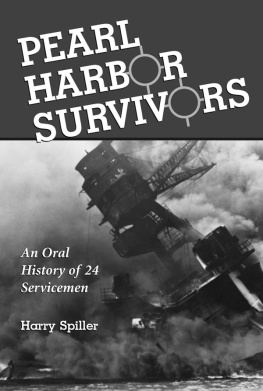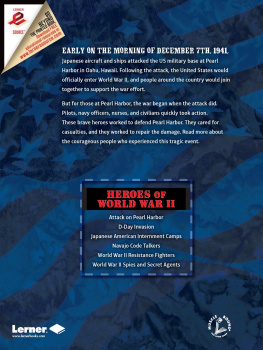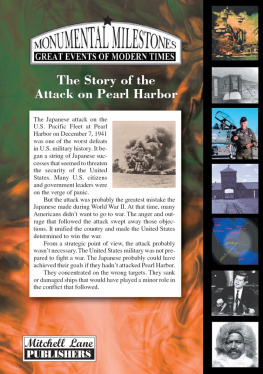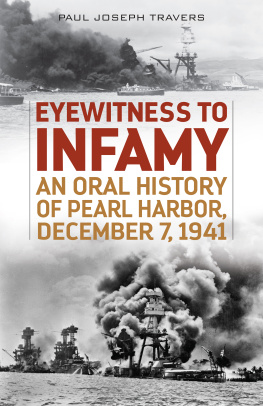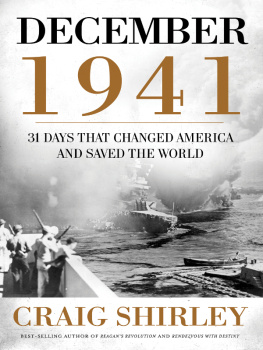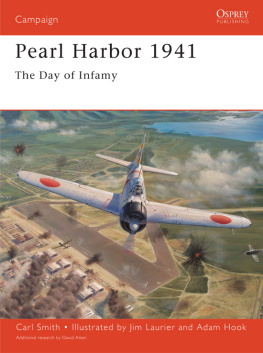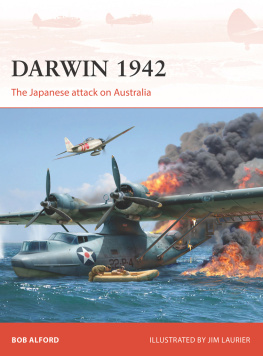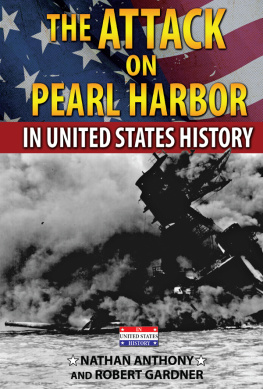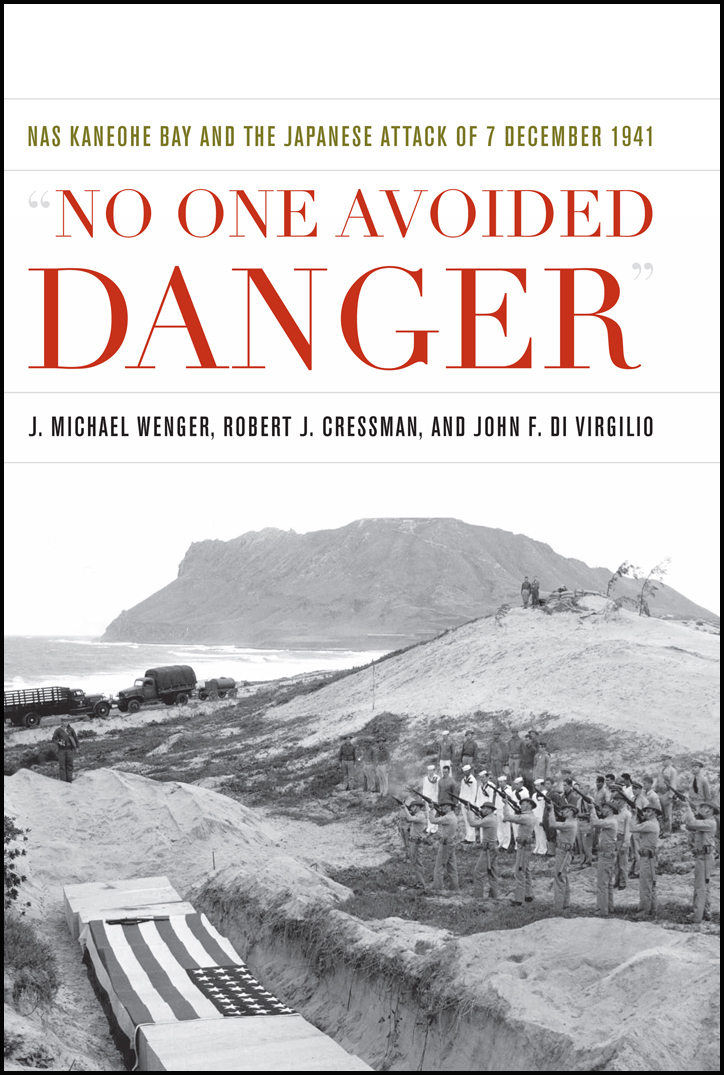
PEARL HARBOR TACTICAL STUDIES SERIES
J. Michael Wenger, Robert J. Cressman, and John F. Di Virgilio, editors
W ith nearly three-quarters of a century having passed since 7 December 1941, it seems counterintuitive that no comprehensive, tactical history exists for the Japanese attacks on the island of Oahu. It is only within the span of the last two decades that much of the material and documentary evidence relating to the attacks has become generally available to historians and researchers. This material not only spans far-flung repositories in the United States and Japan, but also bridges a vast chasm separating two very different cultures, complicating the materials use.
The Pearl Harbor Tactical Studies series seeks to fill this wide gap in military history by diving down to the lowest levels of practical, personal, and tactical details. The goal of these works is to promote a deeper understanding of the events of 7 December 1941, and to convey the chaos and magnitude of the disaster on Oahu, as experienced at an individual level. Compilation of such a series has been possible only through a careful survey of the widest spread of records and accounts from both sides, resulting in comprehensive accounts that document the epic American-Japanese struggle on and over Oahu, and the intensely human tragedy of that day.

This book has been brought to publication with the generous assistance of Marguerite and Gerry Lenfest.
Naval Institute Press
291 Wood Road
Annapolis, MD 21402
2015 by J. Michael Wenger, Robert J. Cressman, and John F. Di Virgilio
All rights reserved. No part of this book may be reproduced or utilized in any form or by any means, electronic or mechanical, including photocopying and recording, or by any information storage and retrieval system, without permission in writing from the publisher.
Names: Wenger, J. Michael, author. | Cressman, Robert, author. | Di Virgilio, John F., author.
Title: No one avoided danger: NAS Kaneohe Bay and the Japanese attack of 7 December 1941 / J. Michael Wenger, Robert J. Cressman, and John F. Di Virgilio.
Other titles: NAS Kaneohe Bay and the Japanese attack of 7 December 1941
Description: Annapolis, Maryland: Naval Institute Press, [2015] | Includes bibliographical references and index.
Identifiers: LCCN 2015030901 | ISBN 9781612519258 (ebook)
Subjects: LCSH: Pearl Harbor (Hawaii), Attack on, 1941. | Kaneohe Bay Naval Air Station (Hawaii)History. | World War, 1939-1945HawaiiKaneohe. | World War, 1939-1945Aerial operations, American. | Kaneohe (Hawaii)History, Military.
Classification: LCC D767.92 .W464 2015 | DDC 940.54/26693dc23 LC record available at http://lccn.loc.gov/2015030901

 Print editions meet the requirements of ANSI/NISO z39.481992 (Permanence of Paper).
Print editions meet the requirements of ANSI/NISO z39.481992 (Permanence of Paper).
23 22 21 20 19 18 17 16 15 9 8 7 6 5 4 3 2 1
First printing
Most photographs are U.S. Navy official, from the collections of the National Archives and Records Administration (NARA II or NARA, St. Louis), the Naval History and Heritage Command (formerly the Naval Historical Center) (NHHC), National Personnel Records Center (NPRC, St. Louis), National Naval Aviation Museum (NNAM), or are from private collections. Photos marked 71-CA, 72-AC, 80-CF, 80-G, and 127-GS can be found at NARA II in College Park, Maryland. The NHHCs photos are distinguished by the NH prefix. Photos with a USAR prefix are from World War II Valor in the Pacific National Monument. Photos loaned or given by individuals are indicated by the donors last name. Photos marked BKS can be found at the War History Library (Senshi bu) of the Japan Defense Agency, War History Office (Boeicho Kenshujo Senshishitsu).

To the Klippers of Kaneohe, the forgotten heroes of 7 December 1941
Table of Contents
Guide


Contents


O f the major American military airfields on Oahu that came under attack on 7 December 1941, none lay farther away from the U.S. Pacific Fleet at Pearl Harbor than did Naval Air Station (NAS) Kaneohe Bay on the islands windward shore. Situated on Mkapu Peninsula approximately fifteen air miles east-northeast of Pearl, the station seemed something of a backwater, isolated by distance and the jagged Koolau mountains. A historical byproduct of that isolation is that the events of 7 December 1941 that unfolded there receive, at best, superficial coverage in most accounts of the attacks on Oahu. Hence, comparatively little is known regarding the battle that took place along the picturesque shores of Kneohe Bay.
Like many of the wartime facilities in Hawaii, Kaneohe remains an active military basecurrently Marine Corps Base Hawaii. Among the hangars and parking aprons at what was once NAS Kaneohe Bay, however, Americans battled the attacking Japanese with courage and resolution that matched that of their adversaries. One of the great, but inevitable, misfortunes that occur in the aftermath of war is that the valor and heroism of brave men comes to be remembered dimly with the passing of generations. The American soldiers, sailors, and Marinesstill living at the time of this writingwho were the object of the attacks on Oahu feel this phenomenon keenly. We hope this work will bring to life the story of the valiant defenders of NAS Kaneohe Bay on 7 December 1941 and ensure that their story will edify and inspire those who read it.
J. Michael Wenger,
Robert J. Cressman,
John F. Di Virgilio
1 August 2015


A book such as this is necessarily the product of the supporting labors of many, from trained archival specialists to friends and colleagues in the field and those who lived through these momentous events. Some no longer work in the archives in which we began our research, but our feeling of indebtedness lingers as we remember assistance rendered. Many veterans with whom we talked or corresponded, sadly, have died.
In particular, this work stands on the shoulders of two individuals without whose resources any work dealing with the Pearl Harbor epic would fall woefully short of the mark. Dr. Gordon W. Pranges papers remain an unparalleled source of information. We especially thank Jennie A. Levine at the University of Maryland and Dr. Donald M. Goldstein, Marianne Kasica, and Michael Dabrishus of the University of Pittsburgh for making Dr. Pranges materials available. Similarly, Walter Lords work is practically synonymous with the attack on Oahu. Access to his interviews, questionnaires, and correspondence came to us via archivist Curtis Utz of the Naval History and Heritage Command.


